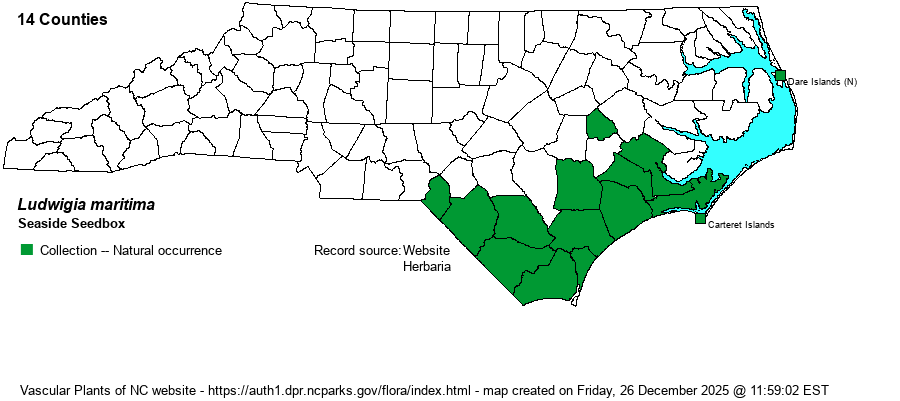| Author | R.M. Harper | |
| Distribution | Limited to the southern third of the Coastal Plain, plus records for Roanoke Island in Dare County.
This is a Coastal Plain species, ranging north only to eastern NC, and south through FL and then west to eastern LA.
| |
| Abundance | Declining in the state in recent years. Formerly infrequent, but now generally rare to uncommon, even in well-maintained pinelands. Very rare as far northeast as Dare County. This is a Watch List species. | |
| Habitat | This species generally grows in pine savannas and pine flatwoods. However, a number of records are from sandy soil, but where moist or damp, in flatlands. |
| Phenology | Blooms from June to September, and fruits shortly after flowering. | |
| Identification | This is one of the relatively few showy species of Ludwigia, and is one of three similar species that grow mainly in the state's pine savannas. It is erect, sparsely branched, growing to about 2-2.5 feet tall, with pubescent stem and leaves. The widely scattered stem leaves are alternate, sessile, widely lanceolate, and about 3-4 inches long and 1-inch wide, rounded at both ends and entire on the margins, and quite pubescent. The flowers, in middle and upper axils, are conspicuous, have 4 bright yellow petals, rounded, with the spread flower about 1-inch across. It is always a good idea to check the sepals and capsule of Ludwigia species, and this species has quite hairy sepals, and they are ovate to rounded, about 1/3-inch long, and strongly reflexed. L. hirtella has narrowly triangular sepals that are spreading. In addition, L. virgata is clearly a smooth species overall. You will discover that L. virgata and L. hirtella are reasonably frequent in savannas, but that L. maritima is scarce and may require much searching (and it does not range to the Sandhills). | |
| Taxonomic Comments | None
| |
| Other Common Name(s) | Harper's Seedbox, Seaside Primrose-willow. More references use "Primrose-willow" than "Seedbox", but as other similar members are generally named as Seedbox, there is no reason to use Primrose-willow for this group of Ludwigia species, preferring to use this name for the very tall species. | |
| State Rank | S2S3 | |
| Global Rank | G5 | |
| State Status | W7 | |
| US Status | | |
| USACE-agcp | FACW link |
| USACE-emp | FACW link |

